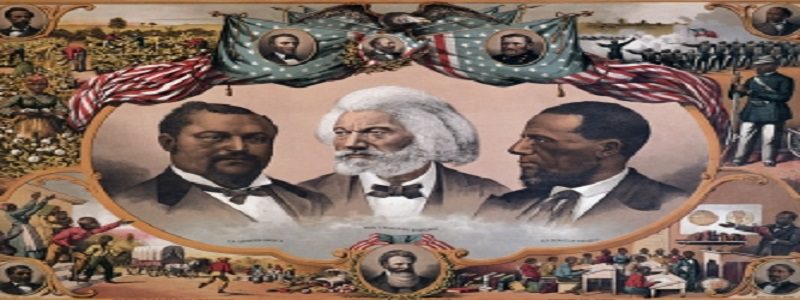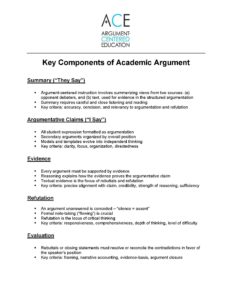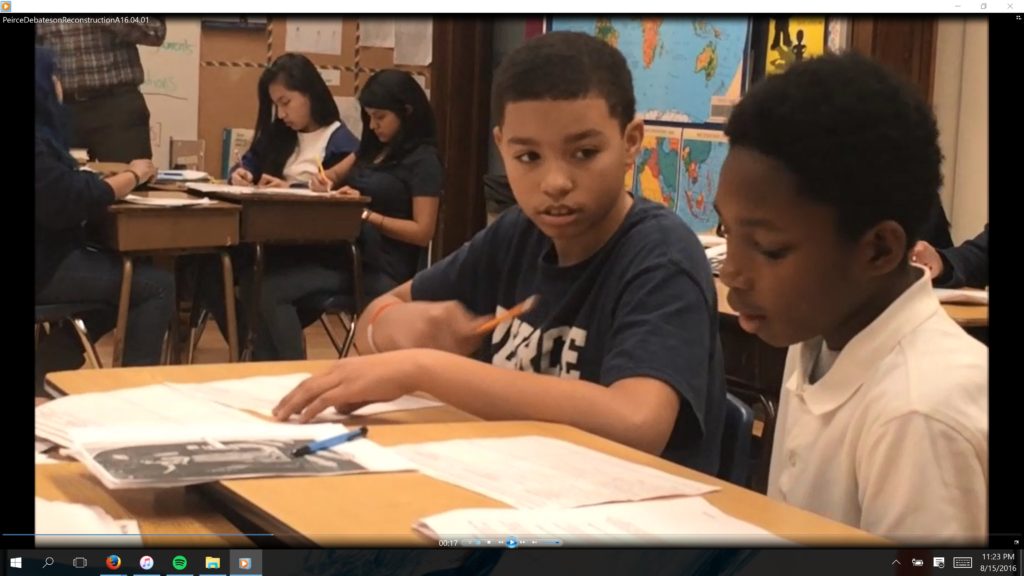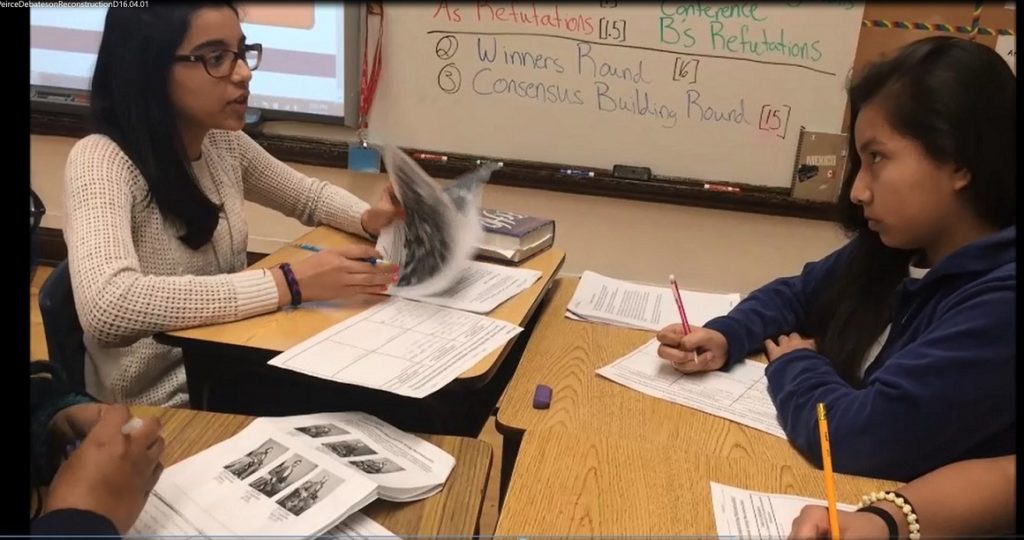
Video in on Table Debates on the Reconstruction Era, Part 1
Oftentimes, the best way to investigate a teaching method or pedagogical approach is visual, via video.
The Helen C. Peirce School of International Studies, a K – 8 school in Chicago’s Edgewater neighborhood, conducted an ACE-supported argument-based project on the Reconstruction Era (1865 – 1877), following the Civil War, in their 7th grade Humanities classrooms last spring. Thanks to the immersive-learning and naturally-skilled guidance of lead teachers Ryan Lambert and Tiffany Brugman, the unit culminated in a series of very successful classroom debates. The issue that organized unit content instruction, and that formed the basis for the classes’ argumentation, was this:
Did the Reconstruction Era move African-Americans substantially closer to obtaining equal rights and freedoms?
There were many aspects of the debates that were exemplary, and even more of the unit as a whole. This two-post sequence will focus on six elements of the implementation of the culminating debates themselves that are worth drawing attention to, providing some analysis of what went so right (and a little bit about what can be made even better in the instructional implementation next time).
Even though these video representations of successful classroom debating are drawn from a middle school, the elements of argumentation are directly transferable to the high school setting so high school educators can also take a useful look.
1. Presentation of Organized, Discrete Evidence-Backed Claims
Each of these six highlights will begin with a short video clip that you can click on, which will then be followed by a brief analysis.
In the two-person debating format that Peirce International School used, these two students are presenting their opening arguments on the affirmative side of the issue (Did Reconstruction make African-Americans substantially freer?). They make three clear and discrete (i.e., distinct, separate, not to be confused with “discreet,” i.e., circumspect) claims, alternating in their presentation of them: (1) African-Americans were afforded new Constitutional protections, (2) African-Americans were educated for the first time, and (3) African-Americans were allowed to join (and even conscripted in) the armed forces, conferring a basic obligation of citizenship. All three claims support the team’s overall position, that Reconstruction did succeed in making African-Americans substantially freer. And they do so in a manner that organizes the students’ reasons separately, cleanly, and logically. This is a structural feature that is fundamental to effective academic argumentation. With very few exceptions, students first have to become capable of organizing their thinking for their argumentative position or interpretation into separable and supportable reasons. When those reasons acquire an evidence basis they turn into arguments. We want our students to be making multiple arguments to support and defend their understandings of the academic content they are being taught, addressing its central questions and issues.
These students’ best evidence — and therefore their strongest argument — is for their first claim, that the U.S. Constitution was amended to afford African-Americans with new protections during Reconstruction. Note the student’s opportunistic reasoning here, too: before turning it over to his partner for their second argument, he adds that the equal rights promised by the 14th and 15th Amendments could only be constrained or overturned by additional amendments. He is emphasizing the significance of his evidence as support, ultimately, for his position in this example of reasoning.
Looking for aspects to improve, the evidence for the second argument is thinner: it seems possible that the second student has better evidence in his documents than he is able to summarize or quote while he is speaking. Also, this team’s third claim may be vulnerable to the “technical” counter-argument that the Emancipation Proclamation, freeing southern slaves to fight for the Union, was passed in 1863, so during the Civil War rather than during Reconstruction after the war. This team should be prepared to address that counter-argument.
It is well worth noting that this team’s opponents are carefully tracking the three arguments they are making on their “flow sheets.” Argument-Centered Education believes very strongly in the importance of this instrument across the gamut of structured argumentation and debating formats. Tracking arguments makes argumentation more objective for students and both facilitates and enforces refutation.
2. Effective and Authoritative Administration of Simultaneous Debating
In this video, Mr. Lambert is running a tight ship. Noisy, but loud with the sounds of preparing, conferring, speaking, arguing, questioning. Unlike the video sample above, which was taken from a fishbowled, showcased debate between two teams selected on the basis of the strength of their earlier performance, this clip (like those to come) is taken from regular implementation of Table Debates, happening simultaneously at tables around the classroom, each with four students debating, two on two. Here Mr. Lambert is heard telling his students what teams should be preparing to do next (make, and then respond to, counter-arguments). When the time elapses for this preparation (called, in competitive debating, “prep time”), Mr. Lambert tells “Team B’s” (in an A vs. B match-up at each table) to begin making their counter-arguments to Team A’s arguments. Note the efficiency of Mr. Lambert’s directions, in addition to their authoritativeness. He doesn’t hem and haw. He isn’t verbose. He doesn’t brook questions, entreaties, or complaints. He gives clear and concise directions, and tells students the timings firmly and loudly.
Secondarily, we see a student (recognizable from the previous video — though here he is arguing for the opposition position) making a solid, evidence-based counter-argument against the argument that Reconstruction gave black men the right to vote. This kind of contest of ideas — that Reconstruction did extend the legal franchise, though Black Codes put down practical barriers that made voting in practice sometimes very difficult — is crucial to getting our students to think critically — like historians, and more broadly like educated, reasoning, independent thinkers. We’ll see more of this in the next clip.
3. Responsive Refutation
Refutation, of course, is one of the five Key Components to academic argument:
 And the four criteria for effective refutation are: responsiveness, comprehensiveness, depth of thinking, and level of difficulty. Students have to learn to be able to directly address their opponent’s — or simply a contrary or contradictory — argument. This is what is meant by “responsiveness.” It’s actually easier said than done. Many students mis-hear, misread, or simply wrongly infer what is being argued against their position, or what a skeptic or unconvinced reader or listener could argue. Responsiveness begins with an accurate and concise summary of the argument to be addressed — what Gerald Graff and Cathy Birkenstein refer to as the “They Say . . .” This video clip features three tables executing responsive refutation.
And the four criteria for effective refutation are: responsiveness, comprehensiveness, depth of thinking, and level of difficulty. Students have to learn to be able to directly address their opponent’s — or simply a contrary or contradictory — argument. This is what is meant by “responsiveness.” It’s actually easier said than done. Many students mis-hear, misread, or simply wrongly infer what is being argued against their position, or what a skeptic or unconvinced reader or listener could argue. Responsiveness begins with an accurate and concise summary of the argument to be addressed — what Gerald Graff and Cathy Birkenstein refer to as the “They Say . . .” This video clip features three tables executing responsive refutation.
The second table in particular, displays the girl in the white blouse directly addressing the three arguments of her opponent. She refers to the first (“You say that the blacks were elected to Congress during Reconstruction”), and then responds that pervasive racist stereotypes, as documented by political cartoons of the time, didn’t dissipate with African-Americans’ few elected offices. She refers to the second (“Your second argument is that they were given education”), and concedes it to some extent (“The government did give them education”) but maintains that “it was clearly limited.” The strength of her counter-argument is mitigated, though, by (a) its lack of reference to the historical documents, its assumed rather than substantiated documentation, and (b) its imprecision on what the limits to African-Americans’ education during Reconstruction actually were. And finally she refers to her opponents’ third argument (“Your argument that they received more supplies from the government”) without the full clarity of her previous two summaries, but counters it by saying that these supplies were inferior, mere “hand-me-downs from whites.” Similar limitation in this counter-argument’s evidence basis, but it is rightly responsive.
Click on for Part 2 to see refutation that is exemplary both for its depth of thinking and for its strength of evidence.




